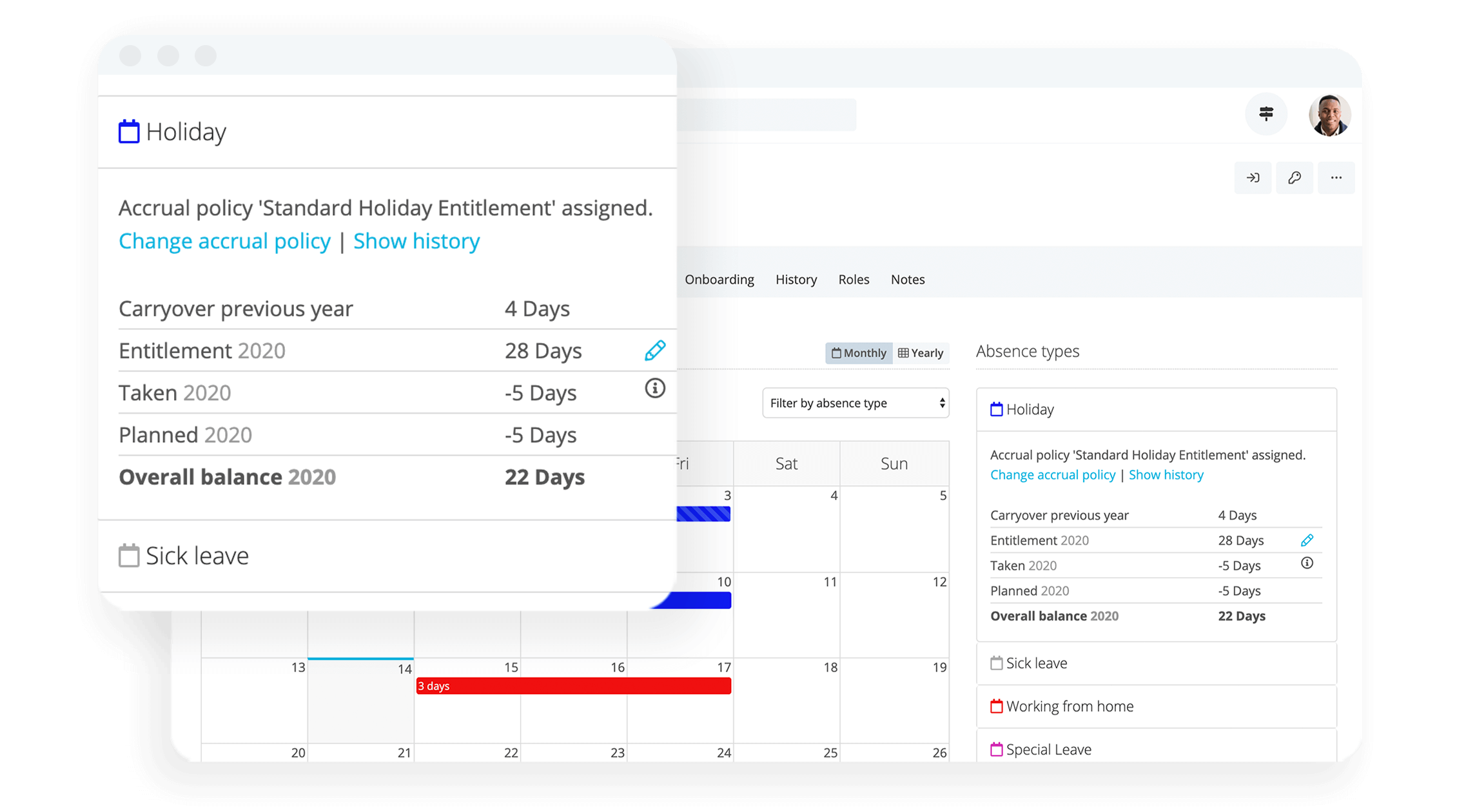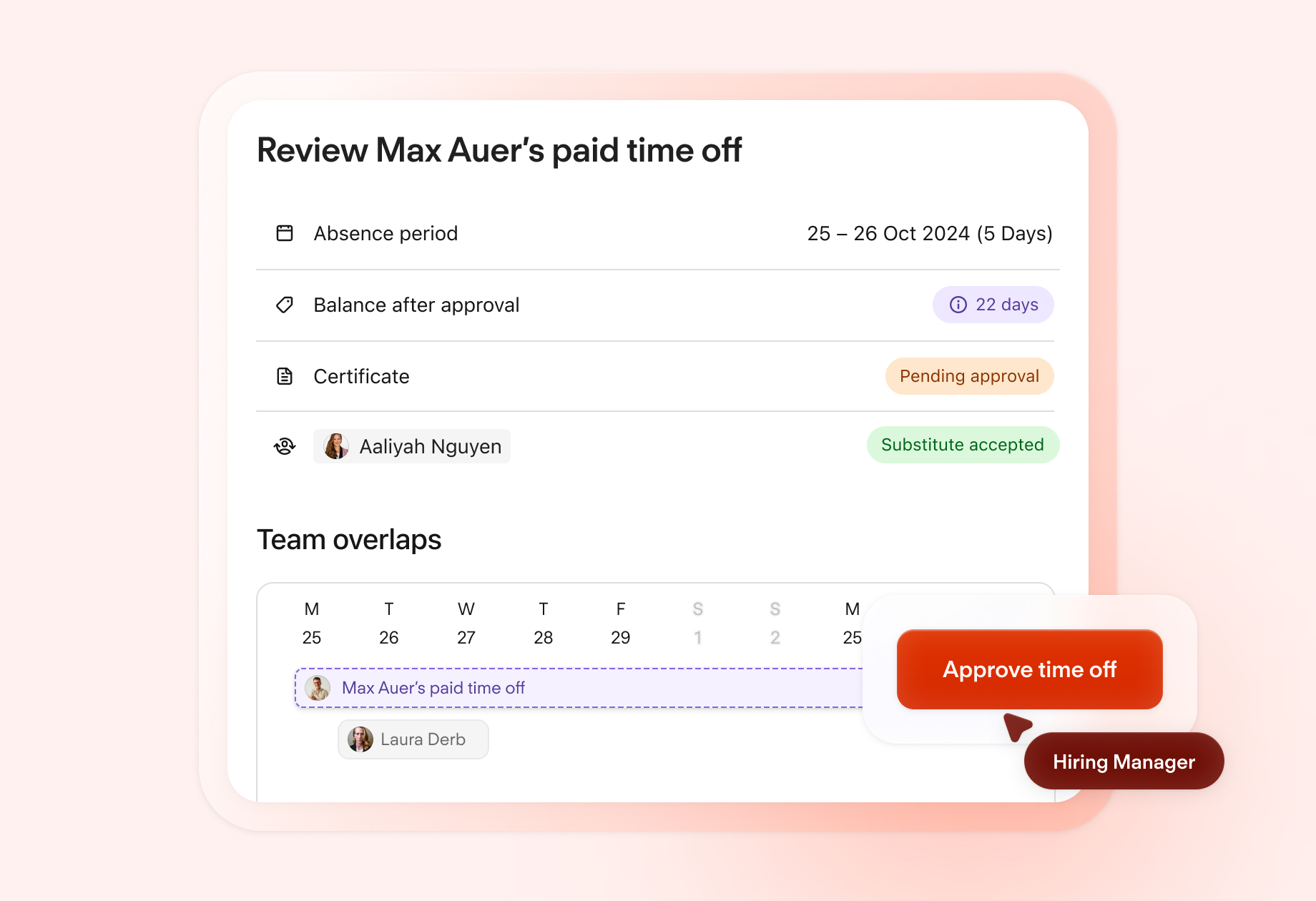Compassionate Leave: How Can UK Employees Take It?

Compassionate leave is a particularly sensitive topic of discussion. That’s because losing a loved one can be one of the most traumatic situations in someone’s life. How do HR leaders cope when this happens to one of their employees?
In this article, we break down the various types of compassionate leave. Then, we discuss the requirements under UK law, thorny issues, and important considerations to make for your future HR processes and policies.
Managing absences is easy with Personio. Click here to learn more.What Is Compassionate Leave?
Compassionate leave refers to the time given to employees in the United Kingdom to grieve and make arrangements following the death of a family member or close loved one. It allows employees time to grieve, make necessary arrangements, and attend a funeral or memorial service.
Compassionate leave is time afforded to employees due to a death in the family or of a close loved one. This allows employees time to grieve, make arrangements, and attend a funeral or service.
Three Types of Compassionate Leave
Not all leave is called the same, as there are different kinds that we’ll illustrate with the chart below:
Type | What It Means |
|---|---|
Compassionate Leave | The most common and popular way to refer to the time an employee takes off in order to deal with the loss of a loved one. |
Bereavement Leave | Essentially the same as compassionate leave, used when employees take off time to grieve the loss of a loved one and make any relevant preparations. |
Grievance Leave | Used interchangeable with compassionate and bereavement leave. It is leave that affords someone the opportunity to grieve for a close relative (and all the potential steps that come with it). |
What Is Special Leave?
Special leave is the term used for time off given to employees, by employers, for a range of extenuating circumstances. This could include paid time off (PTO) or unpaid leave, and is typically in addition to annual leave.
We can’t have a conversation surrounding compassionate or bereavement leave without considering special leave. In short, special leave is leave that encompasses each of these, as well as other situations that could affect an employee’s ability to be present at work.
Do You Need A Special Leave Policy?
A special leave policy offers a framework for employees to request time off in the event of something unanticipated or unexpected. This is to ensure that organisations have the opportunity to make clear what is available to employees and what they should do in the event of emergency requests. Most organisations should definitely have one.
Special Leave Examples
Some examples of special leave may include, but are not limited to:
Serious illness or bereavement of a relative
Unforeseen emergencies that involve dependants
Unexpected domestic emergencies that may arise
Compassionate Leave Examples
How can we make bereavement leave a little bit more tangible? Here are some examples to consider…
Compassionate Leave for Family Emergencies
The first allows employees to take time off to deal with an emergency involving a dependant. For further clarification,nidirectoffers a guide on what counts as an emergency.
According togov.uk, a dependant could be ’a spouse, partner, child, grandchild, parent or someone who depends on you for care’. There is no set amount of time recommended, allocated or required for leave, but it must be reasonable.
While there are no limits on how often employees can take time off for dependants, employers do not have to pay people for taking this type of compassionate leave.
In addition, employees cannot take this type of leave if they knew about a situation beforehand. For example, if an employee needed to take time off for a hospital appointment, this is not classified as compassionate leave.
Instead, employees might be entitled to parental leave. Otherwise, allowing the time off and paying for it remains at the employer’s discretion.
Compassionate Leave for Death
Acas advises that everyone has the right to time off if their partner, parent, child, or someone else who relied on, them died. With that in mind, employers have no legal responsibility to pay employees for the time taken off to cope with a dependants’ death (other than their child).
It is advised, though, that it’s important for employers to be sensitive to what each person might need at the time and to consider the person’s physical and emotional wellbeing: both at the time and once they have returned to work. While there may not be a hard-and-fast rule, everything is contextual in this case.
What Is Compassionate Leave Entitlement?
How much time can an employee take off when it comes to compassionate leave? By the letter of the law, the right is to a ‘reasonable’ amount of time that suits the conditions of the leave. This will be highly contingent on the scenario, though, where one to two days may be appropriate, or a week or more. It all depends.
Gov.uk describes the five practical, necessary steps that must be dealt with when someone dies. This includes registering the death and arranging the funeral to informing the government, dealing with bereavement benefits, pensions, taxes, estates, and even checking whether the person dealing with the death of their loved one needs to apply to remain in the UK.
However, dealing with someone’s death is a much broader issue than addressing the practicalities of life without them. This is why the concept of ‘reasonable time’ is one that is better handled on a case-by-case basis.
Document Special Leave With Ease

Using Personio’s absence management feature, your employees can easily enter any type of leave, and you always have an overview of current and planned absences at any time.
How It WorksHow Do You Build A Compassionate Leave Policy
When it comes to crafting a compassionate leave policy, the first rule for organisations is to be flexible. After all, grief can come in all shapes and sizes, and it is practically impossible to create a one-size-fits-all approach.
So, when it comes to creating a framework, it should be exactly that: An idea of how to tackle the process of special leave, while identifying the fact that it may be different for each employee, each and every time.
The following step-by-step guide should help offer some clear ideas as to what you need to outline in your compassionate leave policy:
Step | Explanation |
|---|---|
Step One: Employee Rights | Any policy needs to start off with an employee's legal right to leave. |
Step Two: Additional Leave | This is an opportunity to articulate your organisation's policy when it comes to additional leave. |
Step Three: Defining Leave | Paid or unpaid? A minimum amount of years worked? How does additional compassionate leave look like in your organisation? |
Step Four: Outline A Process | A tragedy can occur in an instant, and employees need to be able to let people know easily without an additional emotional toll. How do employees easily request or alert colleagues to compassionate leave being taken? |
Step Five: Train Managers | Your managers need to be well-versed in handling compassionate leave. So, offer some training to help them showcase empathy, manage the tasks at hand, and guide people through a tough time. |
Step Six: Encourage Transparency | Make your policy known, share it in an accessible setting, and give everyone the confidence to take compassionate leave and to feel empowered when doing so. |
Compassionate Leave: Frequently Asked Questions
Here are some of the most-asked questions when it comes to compassionate or bereavement leave:
How Much Is Compassionate Leave Pay?
There is no hard-and-fast rule when it comes to compassionate leave pay, and the same goes for bereavement leave pay. Employees may get paid, or they may go on unpaid leave — it all depends on the policy you have in place.
What Is A Compassionate Leave Policy?
Although an employer does not have to state that they allow compassionate leave, since that it is a right for all employees, a compassionate or bereavement leave policy helps set the guidelines for notice periods, the terms of paid or unpaid leave, and anything else an employer believes is necessary when it comes to their unique policy.
What Is Parental Bereavement Leave?
Parental bereavement leave occurs when parents deal with the death of a child, if they die under 18 or after 24 weeks of pregnancy. In these incredibly sad circumstances, parents are entitled to two weeks of both leave and pay.
Are Employers Legally Required To Give Compassionate Leave?
It depends on how you define compassionate leave, and – although a difficult topic – the person who has passed away. Employees who have lost a child (less than 18 years old) or experienced a stillbirth after 24 weeks of pregnancy are entitled to two weeks of statutory parental bereavement leave, as well as statutory parental bereavement pay.
Can An Employer Offer More Compassionate Leave?
Organisations can, of course, provide an employee with more leave. This depends on their approach and how this is enshrined within their policies. That said, employers can only claim £151.20 a week or 90% of their average weekly earnings (whichever is lower) back from the government for the time the employee has taken off.
How Should Employees Return From Compassionate Leave?
Employees also have the right to return to their job after this leave. You can read more about facilitating a successful phased return to work by reading our article on the top right here.
Compassionate Leave: You Need A Clear Policy
HR software, like Personio, can help HR leaders, their teams, and the broader organisation manage documents, policies and procedures to make it easier for everyone to have the information they need at their fingertips when they’re affected by challenging emotional issues.
Disclaimer
We would like to inform you that the contents of our website (including any legal contributions) are for non-binding informational purposes only and does not in any way constitute legal advice. The content of this information cannot and is not intended to replace individual and binding legal advice from e.g. a lawyer that addresses your specific situation. In this respect, all information provided is without guarantee of correctness, completeness and up-to-dateness.
